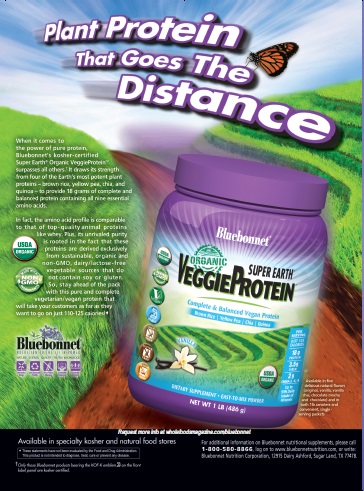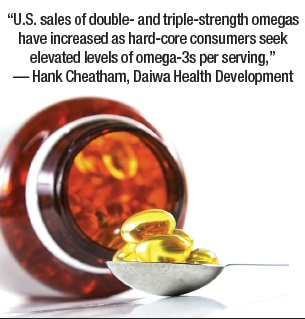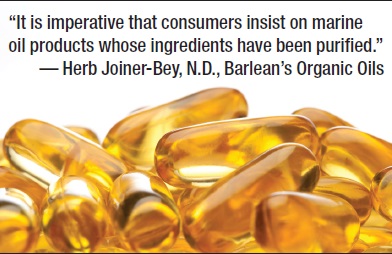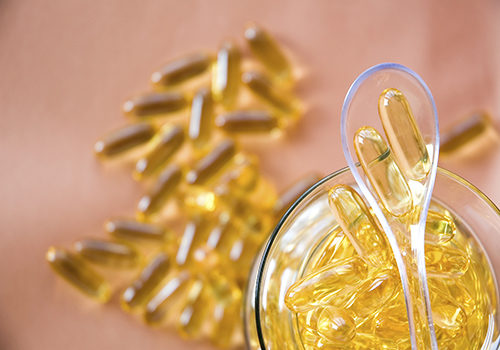In 2014, WholeFoods Magazine reported that global sales of omega-3s were up, but U.S. figures told a different story (1). The Global Organization for EPA and DHA Omega-3s (GOED) said 2013 U.S. omega-3s sales dropped to what they were in 2011, and the bad news continued in 2014 with declines every month consecutively.
It’s time for an update from industry experts. Is the situation improving? Or is the category in an even deeper hole?
Fishing for Answers
The reality is that sales of omega-3 products are complicated. Some products are seeing increased interest, while others are flat. And some consumer groups are staying away while others want even more DHA and EPA.
The big-picture view is that the declines are slowing. Hank Cheatham, vice president of marketing and sales at Daiwa Health Development, Gardena, CA, states, “Sales in North America of omega-3 polyunsaturated fatty acids (PUFAs) have reported shortfalls over the past year and now seem to be beginning to plateau.”
Retailers might find it mind-blowing why marine oil sales are lackluster when they offer so many benefits and have so much research behind them. One reason why fewer shoppers are racing to stores to buy marine oils is that they continue to be inundated with mixed messages about omega-3s. Many attribute the initial drop in fish oil sales to a 2013 study from the Journal of the National Cancer Institute suggesting that omega-3s increase prostate cancer risk (2). “[It] caused a lot of sensational headlines for the category that were hard to combat,” says Michael Lelah, Ph.D., chief research scientist for Mercola, Hoffman Estates, IL. “Since then, the market has had to weather its share of negative research and sensational headlines in high profile media outlets.”
All aspects of the marine oils industry have been targeted, from mercury content in fish to questioning the supplements’ support of cardiovascular and cognitive health. Dallas Clouatre, Ph.D., consultant for R&D at Jarrow Formulas, Inc., Los Angeles, CA, says that even reduced immune function has been blamed on excessive DHA/EPA consumption. And, that’s not all. “One of the great shibboleths of modern medical practice, the chronic use of blood thinners, is presented by some as a reason not to supplement with omega-3 oils despite the fact that better diets likely would reduce the need to intervene medically with blood thinners to begin with,” he states.
 Just weeks before press time for this piece, negative media attention was placed on omegas-3s again, this time in response to a study suggesting healthy fats do not ward off cognitive decline in the elderly (3). The data were collected during the AREDS2 trial. The dosage given (650 mg of EPA and 350 mg of DHA) was very low and the participants were older (average of 72 years)—which combined cannot be expected to show any immediate changes in cognitive decline. But, that did not stop the negative headlines from saying fish oil was a waste of money!
Just weeks before press time for this piece, negative media attention was placed on omegas-3s again, this time in response to a study suggesting healthy fats do not ward off cognitive decline in the elderly (3). The data were collected during the AREDS2 trial. The dosage given (650 mg of EPA and 350 mg of DHA) was very low and the participants were older (average of 72 years)—which combined cannot be expected to show any immediate changes in cognitive decline. But, that did not stop the negative headlines from saying fish oil was a waste of money!
Clouatre says higher dosages may have achieved better results: “A current review indicates that for this purpose, trials usually supplied doses between 430 and 1,100 mg/day of DHA and 150 and 975 mg/day of EPA for six to 18 months, respectively” (4).
Another issue was that many AREDS2 subjects were also taking statins, which interfere with the uptake and utilization of omega-3 oils in the body, explains Clouatre. This situation illustrates that even study findings with major limitations can have an impact on shoppers.
Amidst these stormy clouds, however, are silver linings in the marine oils category. For starters, many in the medical community support the use of marine omega-3s. Marci Clow, M.S., RDN, at Rainbow Light, Santa Cruz, CA, references a 2014 Gallup Study, suggesting that 33% of physicians recommend omega-3/fish oil to their patients (MSI/Gallup Study, 2014). “Since a majority of consumers look to health professionals for advice on supplement use, the continued positive recommendation from health professionals will hopefully help propel a sales rebound and offset declines,” she states.
Also, product innovation in the marine oils category continues to pique consumer interest in supplementation. Says Clow, “While sales do appear to have declined in recent years, there are a lot of great products in this category and potential for rebound and growth.”
She points out that launches of novel delivery forms for omega-3 fish oils are surging such as gummies, functional foods/drinks and vegan forms of omega-3s like algae-derived DHA and EPA. Clow believes the market is also maturing in its offerings of gender-specific omegas as well as condition-specific ones.
Also speaking of popular formulas, Andrew Aussie, executive vice president and chief operating officer at Coromega, Vista, CA, believes that convenience and good taste have a major positive impact on sales for this product segment. He says his firm targets everyone from foodies, to busy professionals, to families and more.
Several interviewees believe shoppers’ preferences are shifting toward krill oil and highly concentrated fish oils. David Hart, vice president of marketing at Qualitas Health, Imperial, TX, says that these “higher-value omega-3 products….are more consumer friendly—smaller capsules for the same omega-3 benefit. So, while sales of refined fish oil are down, these other segments are showing growth.”
John Jarmul, vice president of marketing at Anderson Global Group, Irvine, CA, agrees. He says that sales of marine oils aren’t down across the board. “On the whole, consumer interest remains strong in healthy omega-3 oils. What we have seen is a shift in consumer and brand interest from the conventional lower potency fish oils to the specialty omega-3 concentrates above 70%.”
He feels that this shift can be attributed to the fact that shoppers are getting more educated about the category and want even more EPA/DHA—and higher concentration formulas do the job. “With these custom omega blends, it puts consumers in charge of their own health while giving them exactly what they need and nothing more,” says Jarmul, noting that advances in supercritical CO2 extraction technologies have made higher EPA and DHA concentrations possible. “Supercritical is a solvent-free, green technology that makes it possible for consumers to take their desired level of omegas, in fewer pills, and with less potential contaminants,” he explains.
Others agree that krill is a hot-spot in the marine category. Says Cheatham, “In market research analysis from SPINS, krill oil is recording continuous sales growth. Market share for krill oil is 14% of the total omega-3 product category.”
 He believes krill is drawing shoppers for several reasons, such as being highly bioavailable in the body and having no “fishy” aftertaste. Like fish oil, krill oil has been found to support many aspects of health, including joint, brain, cardiovascular and women’s health.
He believes krill is drawing shoppers for several reasons, such as being highly bioavailable in the body and having no “fishy” aftertaste. Like fish oil, krill oil has been found to support many aspects of health, including joint, brain, cardiovascular and women’s health.
A key take-home message for retailers and other industry members is that they can help turn the tides of marine oil sales as a whole by stocking high-potency and pure, high-quality products. Also, research shows that education about the benefits of marine oils is key to preserving the success of the category.
GOED recently completed a test of an advertising campaign called, “Omega-3s: Always a Good Idea,” that is supported by several industry companies. The goal was to give shoppers independent, reliable information about the benefits of omega-3s. While omega-3 sales during the campaign did not grow to the levels they were before the decline, there was noteworthy growth in omega-3 sales: from –7.68% to –2.55%. With even more financial support and a broader reach, GOED believes that such a campaign could grow sales even more.
And, GOED isn’t alone on the education front. Marci van der Meulen, national sales manager of the retail division at Nordic Naturals, Watsonville, CA, states, “Nordic Naturals takes great pains to educate the public about the health benefits of quality omega-3 nutrition, and the thousands of studies that demonstrate this.”
Cheatham says the future is bright: “In spite of previous stagnant sales in the United States, market research from Packaged Facts projects a growth of 6.4% in omega-3 sales in 2016 versus 2015.”
News to Get Excited About
We have talked about how negative headlines based on subpar research have confused shoppers into thinking it is best to skip marine oils. Now, if your clientele is not so easily swayed, perhaps they would rather hear about why marine oils are a good investment in one’s health.
Aging support. EPA and DHA are well known to support heart, joint, brain and eye health, plus more—and the research is deepening on these topics. But Clow singles out another interesting research development: marine oils may be linked to cellular age. She states, “[DHA] is part of the building block of cell membranes and plays a vital role in membrane fluidity, flexibility and permeability. It accumulates in particular neuronal synapses in the brain, but research is inconclusive as to its effect on slowing cognitive decline.”
She says a 2012 study from Ohio State researchers suggested taking omega-3s could slow biological processes linked to aging (5). The group studied overweight but otherwise healthy middle-aged and older participants. Taking omega-3 supplements helped preserve telomeres. “Telomeres are DNA sequences that get shorter when cells divide, so their length is thought to be a measure of a cell’s aging,” Clow explains.
The researchers also found that omega-3s reduced oxidative stress. The Ohio State team said that one should strive for a 4-to-1, or even a 2-to-1 ratio of omega-6 to omega-3 fatty acids to achieve these benefits; unfortunately, most Americans’ average intake ratio is about 15-to-1.
Brain health. It is well known that the brain needs healthy fats for proper development and function. But, researchers continue to unlock more information about how these healthy fats support the “command center” on many fronts. For instance, Clow is also impressed by a new meta-analysis of 26 studies suggesting that fish consumption is linked to a reduction in depression (6). Some researchers even feel that DHA is key for mood support during and after pregnancy, when some women are susceptible to post-partum depression.
Jolie Root, senior nutritionist and educator at Carlson Laboratories, Arlington Heights, IL, says a 2015 study implied that EPA/DHA may increase serotonin levels (7). This neurotransmitter affects brain health in many ways. She says the study found “EPA/DHA work in synergy with activated vitamin D calcitriol in making possible the production of brain serotonin. This has relevance for autism, ADHD, bipolar depression, schizophrenia and impulsive behavior.”
Also in the brain health realm, marine oil’s effect on cognitive decline has been a key research topic of late. Clouatre says that one recent study associated fish oil intake with reduced brain atrophy in older individuals and slower Alzheimer’s disease progression in those both with the disease and a certain genetic marker for it (8). Also, healthy subjects without Alzheimer’s had better mental state scores.
Cheatham says, “Accelerated cognitive decline and mild cognitive impairment correlate with lowered tissue levels of DHA/EPA and supplementation has improved cognitive function.
 Aussie agrees, citing a 2015 study from the International Society for the Study of Fatty Acids and Lipids (9). “Reviewers found that omega-3s benefit and support memory, noting the potential of DHA in treating disease associated with age-related memory decline,” he states.
Aussie agrees, citing a 2015 study from the International Society for the Study of Fatty Acids and Lipids (9). “Reviewers found that omega-3s benefit and support memory, noting the potential of DHA in treating disease associated with age-related memory decline,” he states.
There’s also some research support suggesting that women experiencing stress, moodiness, cramping and other premenstrual syndrome (PMS) symptoms may benefit from marine oils. Seventy women who were diagnosed with PMS took krill oil (as NKO Neptune Krill Oil) or fish oil for three months (10). The krill oil groups reduced their use of pain relievers during their cycles.
Last on the list, numerous studies link DHA to support of memory, behavior and concentration, especially in children. In one trial involving 500 children, serum levels of omega-3s “significantly predicted a child’s behavior and ability to learn” (11).
Exercise recovery. One may not immediately think of marine oils as a sports supplement, but Lelah believes that there is interesting work linking healthy oils to exercise recovery. He says that researchers from the University of Aberdeen in Scotland tested 37 participants’ Omega-3 Index (i.e., a measurement of the percentage of EPA and DHA in red blood cell fatty acids) after six weeks of taking a placebo or two g/day of krill oil (12). Blood samples taken one and three hours after exercising suggested “six weeks of krill oil supplementation can increase PBMC IL-2 production and NK cell cytotoxic activity 3h post-exercise.”
These results were similar to other studies involving fish oil, though the amount given was more.
Heart health. The connection between cardiovascular health and fish consumption played a big role in putting marine oils on the map. The literature continues to develop, but one of the many recent studies on the subject involved in 12 healthy senior citizens (ages 60–80) who took two omega-3 capsules (each with 465 mg EPA acid and 375 mg DHA) twice daily for 12 weeks. The results suggested the supplement significantly decreased pulse wave velocity. The results were comparable to 12 healthy individuals (ages 21 to 35) who followed the same regimen. The senior group also showed improvements in cardiovascular health (13).
Joints and inflammation. DHA and EPA are helpful for supporting healthy inflammation levels in several ways. They are said to convert into anti-inflammatory prostaglandins in the body and also decrease prostaglandin production (14). Moreover, “Omega-3 fatty acids have also been shown to reduce T-cell-mediated inflammation, in part, by suppressed T-cell activation and proliferation,” states Cheatham. These white blood cells are key for acute immune function.
He says krill oil—phospholipid-bound omega-3s—has been studied for inflammation support. “Krill omega-3 phospholipids demonstrated anti-inflammatory activity, lowering C-reactive protein (CRP) levels in a double-blind trial,” Cheatham states. “Utilizing DHA and EPA together with phospholipids and membrane antioxidants to achieve a triple cell membrane synergy may further diversify their currently wide range of clinical applications.”
In one randomized, double-blind study, 90 patients with cardiovascular disease and/or rheumatoid arthritis and/or osteoarthritis took 300 mg/day of a branded krill oil (NKO Neptune Krill Oil) or a placebo for 30 days (15). The effects were apparent even earlier; the krill oil “significantly inhibited inflammation and reduced arthritic symptoms within a short treatment period of seven and 14 days,” Cheatham states.
Marine form. Marine oil involves numerous products, including fish, krill, algal, squid and other oils. Some, like natural fish oil, have a molecular structure that binds omegas to triglycerides as carriers; some other forms are bound to ethyl ester. Meanwhile, as stated previously, krill is phospholipid bound. “There’s still much education needed on the importance of the right molecular form when choosing marine omega oils,” van der Meulen believes.
While some studies suggest one form performs better than others, others have found they are on an even playing field. For instance, Roots says one new study suggests, “it is not the form of EPA/DHA that makes the difference, it is the dose.” The study found EPA/DHA sourced from either krill or fish oil had similar effects on the Omega-3 Index after one month (16).
Marine Oil: Top Priorities
While health benefits are a top concern for marine oil shoppers, there are other important issues to consider. What’s at the forefront of consumers’ minds?
Sustainability. “Health benefits are the most important reasons consumers purchase krill oil omega-3s. But this is not enough today,” states Lelah. “Sustainability and its cousin, traceability, are part of the package.” Concerns about ocean life and their sustainability are fueling these concerns.
Krill oil has been in the hot seat in the past regarding sustainability issues, but proponents feel krill is successfully produced with the environment in mind.
For instance, Lelah says his company only sources krill oil that is certified by The Marine Stewardship Council (MSC) for sustainability. He explains, “MSC certification takes into account the unique, patented harvesting system developed by our krill oil supplier and partner—Aker BioMarine—that is utilized to trawl and harvest the krill. The system almost completely eliminates by-catch and ensures that only krill are harvested.”
In addition, researchers keep a close eye on the amount of krill that is caught annually, “and only a very tiny percentage of the krill in an area is harvested. This ensures that the krill is responsibly and sustainably maintained,” Lelah states.
 Fish oil makers also have sustainability in mind. Aussie says his firm only uses wild-caught, deep-water, small fish, which reproduce quickly and harbor fewer toxins, making them a more eco-friendly catch than some other species.
Fish oil makers also have sustainability in mind. Aussie says his firm only uses wild-caught, deep-water, small fish, which reproduce quickly and harbor fewer toxins, making them a more eco-friendly catch than some other species.
Meanwhile, Clow’s company sources only wild-caught fish from Peru, which she says is “the world’s Number One sustainable fishery ecosystem.” Like Aussie, she says her firm uses only non-endangered, small-species fish to reduce its impact on the ocean.
According to Hart, there has been increased interest in vegetarian sources because of concerns about sustainability. “Omega-3s that come from a farmed algal source are the most sustainable: they do not impact the fragile marine ecosystem and are able to utilize resources like sunlight and desert scrubland in a productive manner,” he explains.
Algal DHA is now a common addition to prenatal supplements, functional foods and drinks, condition-specific supplements and more. Hart’s company is one of few that is branching out to EPA from farmed microalgae. “Almega PL, from Qualitas Health, is sourced from farmed algae. The omega-3 oil can be fully traced back to the farm and to the day it was harvested. By being vertically integrated from algae cultivation through extraction, we are able to control the whole process,” he states.
Purity and freshness. Shoppers need to be assured that the supplements they buy are pure, since toxins (like mercury, lead and PCBs) can accumulate in fish.
“Manufacturers must remove these through the purification processes, so it’s essential that a person choose a brand that has a reputation for excellent product purity, and that it makes information on purity readily available to customers,” says van der Meulen.
What exactly do these processes look like? Clouatre points out that molecular distillation and some Council for Responsible Nutrition and proposed U.S. Pharmacopeia monograph standards “are the touchstone for quality here.”
Meanwhile, Jarmul says that supercritical extraction is a great tool for making higher potency concentrates in an eco-friendly way because not much waste is involved and there are lower levels of contaminants. He states, “The method in which the oils are processed makes a big difference in the quality that ends up in the consumer’s hands.”
Cheatham says Antarctic krill (Euphausia superba) is naturally very pure because of where they are farmed: “from the very bottom of the food chain in the pristine Antarctic oceans; there is no accumulation of contaminants unlike marine life higher on the food chain.” His firm also tests at least three times to make sure the potency is spot on and there is no toxicity before the product is sold.
On a related topic, marine oils won’t be helpful if they are rancid. Joiner-Bey says that EPA and DHA are the most polyunsaturated in our diet and in the body. That means they have numerous double bonds “where oxygen can grab hold of the molecules, causing rancidity.” He explains that EPA has five double bonds and DHA has six double bonds.
Marine oils, therefore, should be extremely fresh and protected from rancidity with added fat-soluble antioxidants. “The purity and potency of marine oils need to be laboratory-tested and certified as meeting the latest standards set by the World Health Organization and the Council for Responsible Nutrition (CRN),” Joiner-Bey states.
 Transparency. At the end of the day, “seeing is believing” for consumers who want to ensure products are pure and potent. Manufacturers are accomplishing this in several ways. Like Joiner-Bey stated, companies are turning to rigorous third-party testing. And, many are combining such testing with transparency. For instance, Root says her company uses the International Fish Oil Standards Program, which publishes the results of product testing on its website for all to see.
Transparency. At the end of the day, “seeing is believing” for consumers who want to ensure products are pure and potent. Manufacturers are accomplishing this in several ways. Like Joiner-Bey stated, companies are turning to rigorous third-party testing. And, many are combining such testing with transparency. For instance, Root says her company uses the International Fish Oil Standards Program, which publishes the results of product testing on its website for all to see.
Some companies, like Mercola, are making products 100% traceable, down to the coordinates where the krill from a given bottle was caught, “so consumers can see for themselves each step in the krill production process,” says Lelah. He explains, “Consumers can plug this information into Google maps and see for themselves the exact location where the krill was harvested. This is the ultimate in transparency.”
Becky Wright, marketing director at Aker BioMarine Antarctic US, Oslo, Norway, says transparency is far from being a buzzword. She cites a recent Forbes article indicating that seven out of 10 shoppers are familiar with the term transparency as it relates to a company’s business practices. Transparency is expected, she states.
“We believe the same is true for dietary supplements, and in particular, those that contain marine oils,” Wright states. Her firm believes its job of supplying high-quality krill products is not complete without making a 100% traceable supply chain from sea to shelf. “Today, consumers are more in tune with their product ingredients and curious as to where they come from. To that end, Aker’s fishing operations are conducted with full transparency, giving consumers the confidence that the business is well managed,” she added.
As a retailer, you should always feel that you have the right to ask for documentation of purity and sourcing. Says van der Meulen, “We appreciate our customers’ insistence on knowing where their products come from, how they are made, what standards they adhere to, because we know they’ll like what they see when it comes to our products.” She adds that the firm readily provides Certificates of Analysis upon request. “They document the essential features of our oils (purity, freshness, quality standards, etc.) so that customers can be sure they’re getting the highest-quality omegas,” she explains.
 Food companies that specialize in seafood are also making waves with transparency. For starters, Fishpeople, Portland, OR, a 2015 WholeFoods Who’s Who honoree (p. 24), makes sure its entire supply chain is sustainable and the source of each pouch can be traced by shoppers.
Food companies that specialize in seafood are also making waves with transparency. For starters, Fishpeople, Portland, OR, a 2015 WholeFoods Who’s Who honoree (p. 24), makes sure its entire supply chain is sustainable and the source of each pouch can be traced by shoppers.
Meanwhile, Antonio Esquivel, country manager at Tonnino, says transparency also means clear labels. “Let the consumer see what they are buying, what they are paying for,” he states. Shoppers that are looking for specific ingredients and or if a product is gluten or allergen free will appreciate it, he feels.
Natalie Webster, founding family member of American Tuna, Bonita, CA, says a shopper’s top priority when choosing wild seafood should be its origin, how was it caught and whether it is sustainable.
“American Tuna provides wild tuna, albacore, yellowfin and skipjack, which is clearly labeled where it was caught, how it was caught, and carries the MSC eco-label for sustainability. American Tuna was the first canned tuna in the United States to carry the MSC logo on its label,” she states.
And at Safe Catch, Sausalito, CA, Sean Wittenberg, president and cofounder, says, “Purity is priority one,” particularly for “health-conscious consumers and sensitive groups like pregnant women and kids.”
He says his firm tests every single tuna for mercury and “has the lowest mercury limit of any brand of canned tuna.” He says testing every fish is important because mercury levels can vary wildly even in two identical-looking tuna.
|
Select Marine Product Offerings Aker BioMarine: Superba Krill. |
Taste. Some shoppers are very sensitive to the “experience” of taking supplements, and fishy burps or an aftertaste just won’t cutit. “Interestingly, while efficacy and quality are the first two attributes consumers seem to look for, it’s taste that brings them back,” says Aussie.
Some makers flavor their oils with lemon, lime or orange flavors, but some shoppers want even more options. Companies like Nordic Naturals, Barlean’s and Coromega offer yogurt-like emulsified oils in a variety of unique flavors. Aussie points out that while taste is key, this format has other benefits, too. “With our emulsified form, it helps eliminate fishy burps and aftertaste because it’s easier for the body to digest and absorb,” he states.
Purpose. Though shoppers are getting savvier about their purchasing decisions for marine oils, retailers can still provide some extra guidance about which form to take for what purpose. Says Clouatre, “EPA is more powerful for controlling inflammation, hence for joint and cardiovascular issues, whereas DHA is more significant for brain, eye and other neural issues.”
DHA is also key for fetal and childhood development, and is important for pregnant and lactating women to consume.
Those looking for general overall wellness should strive for a healthy balance of EPA and DHA. Speaking of balance, Root says that consumers should shoot to get their Omega-3 Index levels of EPA/DHA to 8%, “which probably requires an adult dose of 1000 to 1,500 mg EPA/DHA daily over a period of 12–16 weeks.” The American Heart Association, she adds, suggests healthy adults consume a minimum of 500 mg/day of EPA/DHA, those with cardiovascular risk take in 1,000 mg/day and those with severely elevated triglyceride levels consume 2,000–4,000 mg/day. WF
See WholeFoodsMagazine.com/Supplements for more coverage of the supplements category.
References
1. K. Chiarello-Ebner, “Keys for Reeling in Omega-3s Sales,” WholeFoods Mag. 37 (9), 54–62, (2014).
2. T.M. Brasky, et al., “Plasma Phospholipid Fatty Acids and Prostate Cancer Risk in the SELECT Trial,” J. Natl. Cancer Inst. (2013); doi: 10.1093/jnci/djt174; First published online: July 10, 2013.
3. “NIH Researchers Say Omega-3s Do Not Support Cognitive Health,” WholeFoods Mag. 9 (2015).
4. Nutr. Hosp. 32 (n02), 528–533 (2015).
5. “Omega-3 Supplements May Slow A Biological Effect of Aging,” Oct. 1, 2012, http://researchnews.osu.edu/archive/omega3aging.htm, accessed Sept. 27, 2015.
6. F. Li, X. Liu and D. Zhang, “Fish Consumption And Risk Of Depression: A Meta-Analysis,” J. Epidemiol. Community Health, doi:10.1136/jech-2015-206278.
7. R.P. Patrick and B.N. Ames. “Vitamin D and the omega-3 Fatty Acids Control Serotonin Synthesis And Action, Part 2: Relevance For ADHD, Bipolar, Schizophrenia, And Impulsive Behavior,” FASEB Journal, February 2015 DOI: 10.1096/fj.14-268342
8. L.A. Daiello, et al., “Association Of Fish Oil Supplement Use With Preservation Of Brain Volume And Cognitive Function,” Alzheimers Dement. 11 (2), 226–235 (2015). doi: 10.1016/j.jalz.2014.02.005. Epub 2014 Jun 18.
9. http://www.journals.elsevier.com/prostaglandins-leukotrienes-and-essential-fatty-acids-plefa/
10. F. Sampalis, “Evaluation of the Effects Of Neptune Krill Oil On The Management Of Premenstrual Syndrome And Dysmenorrhea,” Altern. Med. Rev. 8 (2), 171–179 (2003).
11. T. Pedersen, “Omega 3 Strongly Linked to Behavior, Learning in Children,” http://psychcentral.com/news/2013/09/14/omega-3-strongly-linked-to-behavior-learning-in-children/59556.html, accessed Sept. 29, 2015.
12. M. Da Boit, et al., “The Effect of Krill Oil Supplementation on Exercise Performance and Markers of Immune Function,”
PLoS One, 10 (9), e0139174 (2015). doi: 10.1371/journal.pone.0139174.
13. K.D. Monahan, et. al., “Effect of Omega-3 Polyunsaturated fatty Acid Supplementation on Central Arterial Stiffness and Arterial Wave Reflections in Young and Older Healthy Adults, “ Physiol. Rep. 3 (6), 2015, e12438.
14. “Inflammation,” http://web.stanford.edu/group/hopes/cgi-bin/hopes_test/omega-3-fatty-acids, accessed Sept. 29, 2015.
15. L. Deutsch, “Evaluation of the Effect of Neptune Krill Oil on Chronic Inflammation and Arthritic Symptoms,” J. Am. Coll. Nutr. 26(1), 39–48 (2007).
16. K. Yurko-Mauro et al., “Similar Eicosapentaenoic Acid And Docosahexaenoic Acid Plasma Levels Achieved With Fish Oil Or Krill Oil In A Randomized Double-Blind Four-Week Bioavailability Study,” Lipids in Health and Disease (2015) 14:99 DOI 10.1186/s12944-015-0109-z
Published in WholeFoods Magazine November 2015











